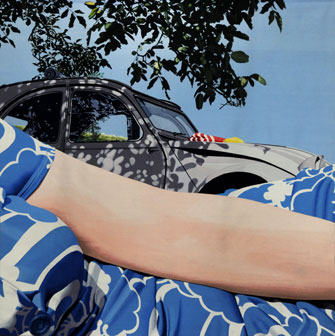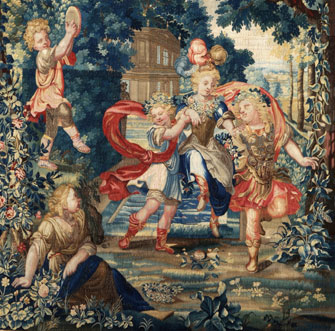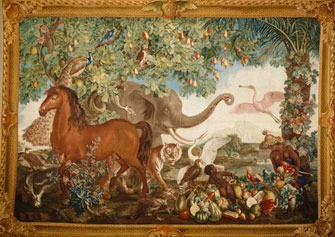A Living Métier
Tracks the Stages of Life

“Ça Sent Bon” (1987), after Gérard Schlosser. Beauvais
As works of art go, tapestries are not particularly sexy, but they have their own special allure and reward long contemplation, with their tactile surfaces, rich colors and, especially in the case of antique tapestries, their intricate scenes, which reveal more and more fascinating detail the longer you examine them, not surprising considering that they once provided not only warmth in chilly châteaux but also entertainment and edification with their mythological or biblical stories.
The city of Beauvais, an hour north of Paris, is currently celebrating the 350th anniversary of its Manufacture Nationale de la Tapisserie, founded in 1664 by Louis XIV’s minister Colbert and still operating (it creates new tapestries owned by the Mobilier National and used to decorate embassies, ministries and other public buildings, helping to preserve an art that might otherwise be lost). The exhibition “Beauvais: 350 Years,” being held at the Galerie Nationale de la Tapisserie, is a survey of the manufactory’s history that offers a good overview of changing styles across the years.
Curators Marie-Hélène Bersani and Gérald Remy chose “the ages of life” as the show’s theme rather than a chronological presentation, beginning with a couple of tapestries dating from 1664, when the manufactory was founded.
Childhood is represented by “play,” with such pieces as an early-18th-century tapestry

“Jeux d’Enfants. La Danse” (detail, early 18th century), after Florentin Damesoilet. Beauvais
showing children playing with a top, as well as recent works. “Adolescence” is represented, among other pieces, by a 1987 tapestry, “Ça Sent Bon,” after Gérard Schlosser (pictured at the top of this page), that is startling in its modernity when seen next to the 17th-century pieces. “What I wanted to show,” says Remy, “was that the Beauvais manufactory’s vibrant history continues using the same techniques but in the service of contemporary reality.”
The show continues through the ages of life, with digressions to focus on representations of flora and fauna, the specialty of Beauvais, which made works for the aristocracy and later the wealthy middle classes rather than royalty. This section provides an interesting look at changing tastes over time with numerous objects made with Beauvais tapestries, among them furniture and accessories. There are even some cunning handbags from the late 1920s with designs by the likes of fashion designer Paul Poiret and artist Raoul Dufy (several works in the show are based on paintings by the latter).
The exhibition, which includes many cartoons (the full-sized preparatory works for tapestries, now considered works of art in their own right) ends with some of the more recent pieces created by the Beauvais manufactory, based on works by a number of well-known contemporary artists. One of them is “Vendredi,” after Patrick Tosani, a hyper-realistic depiction of a pile of fabrics with their varied textures and colors.
As it does every year, Beauvais is dressing up its other attractions for visitors as well. The Maladrerie Saint-Lazare, one of the last of Northern Europe’s 20,000 medieval leper colonies, is a fascinating place to visit, with its complex of preserved and restored buildings and medieval-style garden. This year, it is hosting a conceptual work of art commenting on the site, “Géométries Variables,” by a collective of artists, designers and architects, Le Cabanon Vertical. Built in the complex’s 13th-century chapel, open to the public for the first time, it is echoed by other pieces around town, one of them in front of the cathedral. Concerts are held regularly in the Maladrerie’s 13th-century granary, known for its exceptionally fine acoustics.
In the evening, the town’s famous cathedral, St. Pierre, and the modern Galerie Nationale de la Tapisserie next to it are lit up with a spectacular light and sound show called “La Cathédrale Infinie” and “Horizons Imaginaires,” by the Skertzó agency.
Meanwhile, in Paris, another major tapestry show, “Les Gobelins in the Age of Enlightenment: A Golden Age at the Royal Manufactory,” is being held at La Galerie des Gobelins, which was devoted to making tapestries for the royal court. In addition to a

“Nouvelles Indes. L’Eléphant” (1788-92), after Alexandre-François Desportes. Manufacture des Gobelins
number of extravagant tapestries brimming with fabulous detail, the gallery is presenting an installation by artists Pierre et Gilles, who have decorated an entire room in their inimitably kitschy style, placing a photographic homage to Marie Antoinette (with model and lingerie designer Zahia Dehar, known as “la scandaleuse” in France, posing as the queen) in the center of a room with period furnishings invaded by playful stuffed rats.
Cathédrale Saint-Pierre: Rue St-Pierre, 60000 Beauvais. Tel.: 03 44 48 11 60. Son et lumière: through September 21. Click here for dates and hours. www.beauvais-cathedrale.fr
Galerie Nationale de la Tapisserie: 22, rue Saint-Pierre, 60000 Beauvais. Tel.: 03 44 15 67 00. Open Tuesday-Friday, noon-6pm, Saturday-Sunday, 10am-6pm. Admission: free. Exhibition through August 24. www.beauvais.fr
Office de Tourisme: 1, rue Beauregard, 60000 Beauvais. Tel.: 03 44 15 30 30. www.beauvaistourisme.fr
Maladrerie Saint-Lazare: 203, rue de Paris, 60000 Beauvais. Tel.: 03 44 15 67 61. www.maladrerie.fr
Galerie des Gobelins: 42, avenue des Gobelins, 75013 Paris. Métro: Gobelins. Tel.: 01 44 08 53 49. Open Tuesday-Sunday, 11am-6pm. Admission: €6. Through January 18, 2015 (Pierre et Gilles through October 4, 2014). www.mobiliernational.fr
Click here to read all of this week’s new articles on the Paris Update home page.
Reader Reaction: Click here to respond to this article (your response may be published on this page and is subject to editing).
Support Paris Update by ordering books from Paris Update’s Amazon store at no extra cost. Click on your preferred Amazon location: U.K., France, U.S.
© 2014 Paris Update
Favorite
